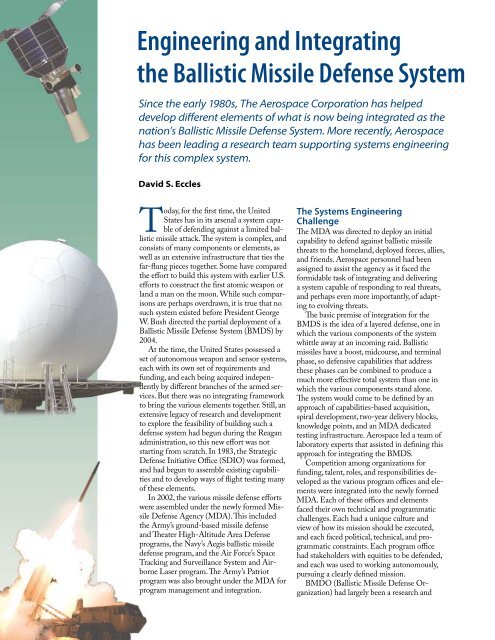Crosslink - Space-Library
Crosslink - Space-Library
Crosslink - Space-Library
Create successful ePaper yourself
Turn your PDF publications into a flip-book with our unique Google optimized e-Paper software.
Engineering and Integrating<br />
the Ballistic Missile Defense System<br />
Since the early 1980s, The Aerospace Corporation has helped<br />
develop different elements of what is now being integrated as the<br />
nation’s Ballistic Missile Defense System. More recently, Aerospace<br />
has been leading a research team supporting systems engineering<br />
for this complex system.<br />
David S. Eccles<br />
Today, for the first time, the United<br />
States has in its arsenal a system capable<br />
of defending against a limited ballistic<br />
missile attack. The system is complex, and<br />
consists of many components or elements, as<br />
well as an extensive infrastructure that ties the<br />
far-flung pieces together. Some have compared<br />
the effort to build this system with earlier U.S.<br />
efforts to construct the first atomic weapon or<br />
land a man on the moon. While such comparisons<br />
are perhaps overdrawn, it is true that no<br />
such system existed before President George<br />
W. Bush directed the partial deployment of a<br />
Ballistic Missile Defense System (BMDS) by<br />
2004.<br />
At the time, the United States possessed a<br />
set of autonomous weapon and sensor systems,<br />
each with its own set of requirements and<br />
funding, and each being acquired independently<br />
by different branches of the armed services.<br />
But there was no integrating framework<br />
to bring the various elements together. Still, an<br />
extensive legacy of research and development<br />
to explore the feasibility of building such a<br />
defense system had begun during the Reagan<br />
administration, so this new effort was not<br />
starting from scratch. In 1983, the Strategic<br />
Defense Initiative Office (SDIO) was formed,<br />
and had begun to assemble existing capabilities<br />
and to develop ways of flight testing many<br />
of these elements.<br />
In 2002, the various missile defense efforts<br />
were assembled under the newly formed Missile<br />
Defense Agency (MDA). This included<br />
the Army’s ground-based missile defense<br />
and Theater High-Altitude Area Defense<br />
programs, the Navy’s Aegis ballistic missile<br />
defense program, and the Air Force’s <strong>Space</strong><br />
Tracking and Surveillance System and Airborne<br />
Laser program. The Army’s Patriot<br />
program was also brought under the MDA for<br />
program management and integration.<br />
The Systems Engineering<br />
Challenge<br />
The MDA was directed to deploy an initial<br />
capability to defend against ballistic missile<br />
threats to the homeland, deployed forces, allies,<br />
and friends. Aerospace personnel had been<br />
assigned to assist the agency as it faced the<br />
formidable task of integrating and delivering<br />
a system capable of responding to real threats,<br />
and perhaps even more importantly, of adapting<br />
to evolving threats.<br />
The basic premise of integration for the<br />
BMDS is the idea of a layered defense, one in<br />
which the various components of the system<br />
whittle away at an incoming raid. Ballistic<br />
missiles have a boost, midcourse, and terminal<br />
phase, so defensive capabilities that address<br />
these phases can be combined to produce a<br />
much more effective total system than one in<br />
which the various components stand alone.<br />
The system would come to be defined by an<br />
approach of capabilities-based acquisition,<br />
spiral development, two-year delivery blocks,<br />
knowledge points, and an MDA dedicated<br />
testing infrastructure. Aerospace led a team of<br />
laboratory experts that assisted in defining this<br />
approach for integrating the BMDS.<br />
Competition among organizations for<br />
funding, talent, roles, and responsibilities developed<br />
as the various program offices and elements<br />
were integrated into the newly formed<br />
MDA. Each of these offices and elements<br />
faced their own technical and programmatic<br />
challenges. Each had a unique culture and<br />
view of how its mission should be executed,<br />
and each faced political, technical, and programmatic<br />
constraints. Each program office<br />
had stakeholders with equities to be defended,<br />
and each was used to working autonomously,<br />
pursuing a clearly defined mission.<br />
BMDO (Ballistic Missile Defense Organization)<br />
had largely been a research and<br />
<strong>Crosslink</strong> Spring 2008 • 20
















